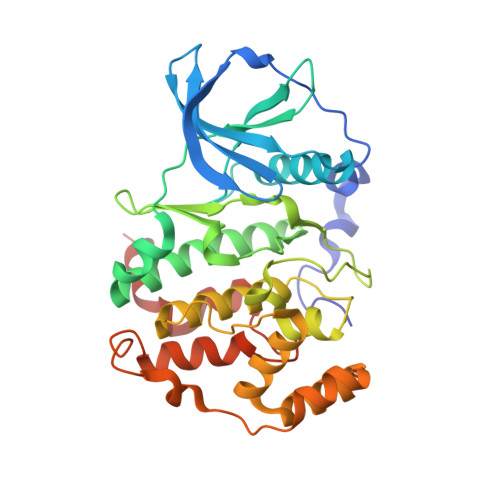Structural features underlying the selectivity of the kinase inhibitors NBC and dNBC: role of a nitro group that discriminates between CK2 and DYRK1A
Sarno, S., Mazzorana, M., Traynor, R., Ruzzene, M., Cozza, G., Pagano, M.A., Meggio, F., Zagotto, G., Battistutta, R., Pinna, L.A.(2012) Cell Mol Life Sci 69: 449-460
- PubMed: 21720886
- DOI: https://doi.org/10.1007/s00018-011-0758-7
- Primary Citation of Related Structures:
3PWD - PubMed Abstract:
8-hydroxy-4-methyl-9-nitrobenzo(g)chromen-2-one (NBC) has been found to be a fairly potent ATP site-directed inhibitor of protein kinase CK2 (Ki = 0.22 μM). Here, we show that NBC also inhibits PIM kinases, especially PIM1 and PIM3, the latter as potently as CK2. Upon removal of the nitro group, to give 8-hydroxy-4-methyl-benzo(g)chromen-2-one (here referred to as "denitro NBC", dNBC), the inhibitory power toward CK2 is almost entirely lost (IC(50) > 30 μM) whereas that toward PIM1 and PIM3 is maintained; in addition, dNBC is a potent inhibitor of a number of other kinases that are weakly inhibited or unaffected by NBC, with special reference to DYRK1A whose IC(50) values with NBC and dNBC are 15 and 0.60 μM, respectively. Therefore, the observation that NBC, unlike dNBC, is a potent inducer of apoptosis is consistent with the notion that this effect is mediated by inhibition of endogenous CK2. The structural features underlying NBC selectivity have been revealed by inspecting its 3D structure in complex with the catalytic subunit of Z. mays CK2. The crucial role of the nitro group is exerted both through a direct electrostatic interaction with the side chain of Lys68 and, indirectly, by enhancing the acidic dissociation constant of the adjacent hydroxyl group which interacts with a conserved water molecule in the deepest part of the cavity. By contrast, the very same nitro group is deleterious for the binding to the active site of DYRK1A, as disclosed by molecular docking. This provides the rationale for preferential inhibition of DYRK1A by dNBC.
Organizational Affiliation:
Department of Biological Chemistry, University of Padua, V.le G. Colombo 3, 35131 Padua, Italy.















